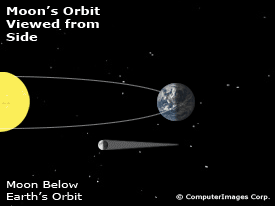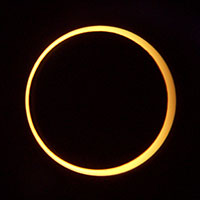Something Is Eating the Sun.

Imagine looking at the sky and seeing the Sun — something that’s there every day — being devoured by an ominous black disk. The ancient Chinese and Incas made noises to scare the demon away.1 It worked, the Sun always came back. Today we know why eclipses occur and can predict them, yet they still continue to fascinate us. What is it that makes them special and why are they so rare?
What Makes an Eclipse? A solar eclipse occurs whenever the Moon passes between us and the Sun. Looking at the Moon’s orbit from above (See Figure 1) this seems to happen every cycle. Yet there isn’t an eclipse every month. Why?

Because space is three dimensional and viewed from the side the Moon’s orbit around Earth is inclined slightly to Earth’s orbit around the Sun (See Figure 2). Most months when the Moon is between the Earth and Sun as seen from above it is slightly above or below as seen from the side. Those months we have a new Moon, which is a very thin crescent and so close to the Sun that it is usually too faint to see (See Figure 3).
Eclipses occur only when the Moon is between the Earth and Sun as seen both from above and the side.

Why Isn’t an Eclipse Visible Worldwide? For the same reason it is such a spectacular sight — the disk of the Moon is the same size as that of the Sun, so they are in perfect alignment only when viewed from a very small area on Earth, typically less than 100 miles wide. People slightly beyond this area see a partial eclipse.
Even though the shadow is small, it typically can be seen at different times by people within a narrow band thousands of miles wide (See Figure 4)? This is because while the eclipse is in progress the Moon is racing in its orbit at more than 2,000 mph2 and its shadow follows. It is similar to an airplane flying overhead — the shadow only covers one small area at a time, but crosses many areas in the course of an entire flight.
What Makes a Total Solar Eclipse So Special? First of all the world goes dark in the middle of the day. Plants and animals begin their nocturnal behavior.

Moreover, because the disks of the Sun and Moon are the same size, the Moon exactly covers the Sun as it passes in front. This allows us to see the Sun’s corona, which looks like a halo. Astronomers also are able to conduct experiments that can only be performed during an eclipse, perhaps the most famous being validation of Einstein’s General Theory of Relativity during an eclipse in 1919.4
The fact that both the Sun and Moon appear to be the same size is the result of an unlikely coincidence: the Sun is 400 times larger than the Moon and also 400 times further away. A person on the Moon watching the Earth eclipse the Sun would see something quite different: the Earth would appear much larger than the Sun and the eclipse would last much longer.

Because the Moon’s orbit is elliptical, it is sometimes too far away to cover the Sun completely. In those cases, called annular eclipses, the blazing disk of the Sun forms a ring around the black disk of the Moon.
* * * * *
Eclipses have fascinated people since the beginning of time. To the ancients they instilled fear as the know order of the world seemed to come undone. To us they inspire wonderment as we observe the mechanics of the universe unfold before our eyes.
-----
- Noel Wanner, The Sun-Eating Dragon, Eclipse Stories, Myths, and Legends, Exploratorium web site (Retrieved August 19, 2017).
- According to the Wikipedia article on Orbital Velocity, the speed varies between 2,170 and 2,416 mph.
- Map by Xavier Jubier from Eclipse2017.org web site.
- Dennis Overbye, The Eclipse That Revealed the Universe, N.Y. Times (July 31, 2017).
- Photo by Wikipedia contributor Smrgeog of May 20, 2012 eclipse. Image from Wikipedia.
This article originally appeared in our free semi-monthly newsletter. To receive future issues, please add your name to the subscription list.

